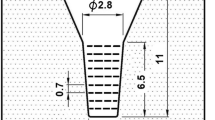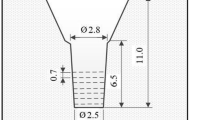Abstract
Subcritical heat treatment of austenite in alloyed cast iron, treated at a temperature below pearlite transformation (A1), has been used to improve matrix hardness without conventional hardening heat treatment. Two series of hypoeutectic 16 and 26 wt% Cr cast irons containing 0, 1, 2 and 3 wt% molybdenum (Mo) were used to investigate the behavior of hardness and retained austenite during subcritical heat treatment. An as-cast test piece was held at subcritical temperatures in 50K intervals from 773K (500C, 932F) to 873K (600C, 1112F) for 21.6 ks to 64.8 ks and then cooled to room temperature by fan cooling. Hardness and volume fraction of retained austenite (Vγ) were measured. In the as-cast state, the hardness decreased gradually but the Vγ increased greatly as Mo content increased in both 16 and 26 wt% Cr cast irons. In the state of subcritical heat treatment, the hardness increased first and then decreased with an increase in holding time. This phenomenon is due to a hardening caused by the precipitation of secondary carbides and by martensite transformation from the destabilized austenite during cooling. At the same Mo content, the degree of hardening was greater in the 16 wt% Cr cast iron than in the 26 wt% Cr cast iron. The Vγ decreased with an increase in both holding time and holding temperature. The maximum hardness in the subcritical heat treatment (HSTmax) was obtained when the specimens were treated at temperatures from 823K (550C, 1022F) to 873K (600C, 1112F) for 50.4 ks. The HSTmax increased gradually in the 16 wt% Cr cast iron but it changed little in the 26 wt% Cr cast iron when Mo content was increased. The highest value of HSTmax, 760 HV30, was obtained in the 16 wt% Cr cast iron with 3 wt% Mo where the Vγ was less than 10%.
Similar content being viewed by others
References
Powell, G.L.F, “Morphology of Eutectic M3C and M7C3 in White Iron Castings,” Metals Forum, vol. 3, pp. 37–46 (1980).
Matsubara, Y., Ogi, K., Matsuda, K., “Eutectic Solidification of High Chromium Cast Iron-Eutectic Structures and Their Quantitative Analysis,” AFS Transactions, vol. 89, pp. 183–196 (1981).
Laird II, G., “Microstructure of Ni-Hard I, Ni-Hard IV and High-Cr White Cast Irons,” AFS Transactions, vol. 99, pp. 339–357 (1991).
Sare, I.R., Arnold, B.K., “The Effect of Heat Treatment on Gouging Abrasion Resistance of Alloy White Cast Iron,” Metallurgical Transactions A, vol. 26A, pp. 359–370 (1995).
Inthidech, S., Sricharoenchai, P., Matsubara, Y., “Effect of Alloying Elements on Heat Treatment Behavior of Hypoeutectic High Chromium Cast Iron,” Materials Transactions, vol. 47, pp. 72–81(2006).
Tabrett, C.P., Sare, I.R., Ghomashchi, M.R., “Microstructure-Property Relationships in High-Chromium White Iron Alloys,” International Journal Materials Reviews, vol. 41, 59–82(1996).
Sun, Z., Zao, R., Li, C., Shen, B., Yan, J., Huang, S., “TEM Study on Precipitation and Transformation of Secondary Carbides in 16Cr-1Mo-1Cu White Iron Subjected to Sub-critical Treatment,” Materials Characterization, vol. 53, pp. 403–409 (2004).
Parks, J.L., “Characteristic of As-Cast and Subcritically Heat Treated High-Chromium-Molybdenum White Irons for Thick-Section Casting,” AFS Transactions, vol. 86, pp. 93–102 (1978).
Inthidech, S., Sricharoenchai, P., Sasaguri, N., Matsubara, Y., “Behavior of Hardness and Retained Austenite in Heat Treatment of High Chromium Cast Iron for Abrasive Wear Resistance,” AFS Transactions, vol. 112, pp. 899–910 (2004).
Sricharoenchai, P., Inthidech, S., Sasaguri, N., Matsubara, Y., “Effect of Alloying Elements on Behavior of Hardness and Retained Austenite of Eutectic High Chromium Cast Irons,” AFS Transactions, vol. 112, pp. 911–923 (2004).
Inthidech, S., Sricharoenchai, P. and Matsubara, Y., “Effect of Alloying Elements on Variation of Micro-hardness during Heat Treatment of Hypoeutectic High Chromium Cast Iron,” Materials Transactions, vol. 49, pp. 2322–2330 (2008).
Inthidech, S., Boonmak, K., Sricharoenchai, P., Sasakuri, N., Matsubara, Y., “Effect of Repeated Tempering on Hardness and Retained Austenite of High Chromium Cast Iron Containing Molybdenum,” Materials Transactions, vol. 51, no. 7, pp. 1264–1271 (2010).
Inthidech, S., Aungsupaitoon, P., Sricharoenchai, P., Matsubara, Y., “Two-body-type Abrasion Wear Behavior in Hypoeutectic 16%Cr Cast Irons with Mo,” International Journal of Cast Metal Research, vol. 23, no. 3, pp. 164–172 (2010).
Kim, C. “X-Ray Method of Measuring Retained Austenite in Heat Treat White Cast Irons,” Journal of Heat Treating ASM, vol. 1, pp. 43–51(1979).
Author information
Authors and Affiliations
Rights and permissions
About this article
Cite this article
Inthidech, S., Sricharoenchai, P. & Matsubara, Y. Effect of Sub-Critical Heat Treat Parameters on Hardness and Retained Austenite in Mo-Containing High Chromium Cast Irons. Inter Metalcast 6, 25–34 (2012). https://doi.org/10.1007/BF03355536
Published:
Issue Date:
DOI: https://doi.org/10.1007/BF03355536




